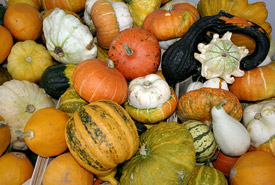Something pumpkiny this way comes

Pumpkins (Photo by Nino Barbieri, Wikimedia Commons)
It’s that time of year when we experience fall everywhere we go: brisk air, turned leaves, harvest displays, the donning of warmer apparel and more. This festive atmosphere becomes even more pronounced with the coming of Thanksgiving, and no celebration is complete without serving up at least one pumpkin dish!
As we gather for another year of thankfulness, here are the top 12 things you didn’t know about pumpkins but always wish you did:
Good gourd, what do you do with all these facts? Why, share them while everyone is talking about pumpkins of course! If you'd like to spice things up with a dash of humour, try this:
What do you get when you divide the circumference of a pumpkin by its diameter? (Answer: Pumpkin pi)
Do you know any neat pumpkin facts? Share them with us in the comment box below!


